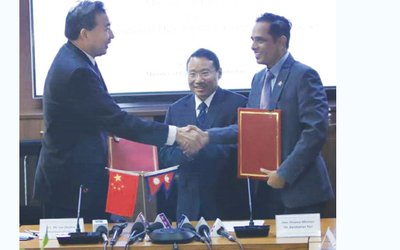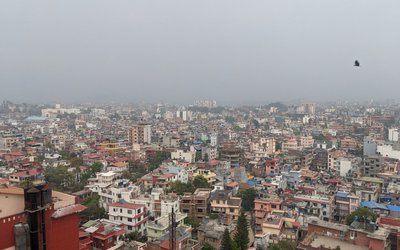The maternal mortality rate has drastically declined in Nepal. The number of school going children has increased. Take the recently released third National Living Standards Survey, Nepal has made a major progress in poverty reduction.
Although the country has been passing through an unstable political situation with frequent changes in the government, one of its visible and noticeable successes is that it is on the way to achieving most of the Millennium Development Goals (MDGs) by 2015.
The country has made significant efforts to increase the enrolment in primary level education. As a result, the net enrolment rate has risen to 93.7 percent in 2010 from 86.8 percent in 2005. The survival rate to completing a full cycle was reportedly 80.6 percent. Similarly, the literacy rate has risen to 86.5 percent in 2010 among 15-24 years old. Similarly, under five mortality rate was at 41 deaths per 1000 in 2009, neonatal mortality rate has also been reduced from 39 deaths per 1000 lives in 2001 to 20 in 2009. The proportion of children immunized against measles has also increased.
According to a recently released report, Millennium Development Goals Needs Assessment for Nepal 2010, the country is on the track to achieve most of its targets by 2015.
The Millennium Development Goals Needs Assessment for Nepal 2010 is a joint initiative taken by National Planning Commission and the United Nations Development Program (UNDP) to estimate the resources needed and to identify gaps towards achieving Nepal’s MDG targets within the next five years (2011–2015).
The analysis suggests that there is a need for considerable increase in resource allocation, particularly for achieving Goals 1, 2 and 7. The report also suggests that the government needs to mobilize both internal and external resources to help address the gaps.
“Most of the MDG targets set for 2015 are likely to be met, as the government is committed to taking ownership of the proposed strategic interventions. While some targets have already been met, others related to employment, survival rate of grade 5, ratio of girls to boys at tertiary levels of education and of literate women to men aged 15-24 years, percentage of birth attended by a skilled birth attendant and universal access to reproductive health and environment will be difficult to meet,” according to Millennium Development Goals: Needs Assessment for Nepal 2010.
The report stresses some strategic interventions. As meeting MDGs targets is a shared responsibility of the concerned government and development partners, internal as well as external resources should be channeled to fulfill the identified resource gaps.
“This report is another step in the right direction. It tells us what interventions are needed to achieve the MDGs by 2015 and how much resources are needed per year between 2011 and 2015. The total resources needed are calculated to be 19.7 billion US$ out of which 6.4 billon US$ or about one third is yet to be identified. A massive task that requires strong leadership from the government,” said Robert Piper, UN Resident and Humanitarian Coordinator. (see box)
Government’s Commitment
The government is trying to show that it is committed to the MDGs.
“The Commission is strengthening the monitoring and evaluation mechanisms to monitor MDG related outcomes,” said Dr. Dinesh Chandra Devkota, former vice-chair of the National Planning Commission. Although I have already resigned, the new government will fully take the ownership and leadership of development strategies.”
In the context of shifting global priorities towards fighting global recession and climate change implications, it is difficult to manage the much needed resources. Nepal has established goodwill among Nepal’s development partners. Despite economic recession, many countries have been generously supporting Nepal.
“As it discusses issues related to health, education, infrastructures and budgets, the report will provide guidelines to the government for formulating policies and development projects in the coming days. The government is committed to MDGs,” said Chief Secretary Madhav Prasad Ghimire. “Nepal’s development partners will come to support us.”
Nepal is on track to achieve the millennium development goals (MDGs) set for 2015 becoming a low-income country on the way to reaching its targets. MDGs report prepared by the National Planning Commission in September 2010 had also shown significant progress in most of the MDGs.
There are eight goals and 21 quantifiable targets which are measured by 60 indicators under the MDGs. The eight goals are eradicating extreme poverty and hunger, achieving universal primary education, reducing child mortality, improving maternal health, combating HIV/AIDS, malaria and other diseases, ensuring environmental sustainability and developing global partnership for development.
According to the report Nepal is close to achieving the goal of universal primary education and reducing maternal mortality. Nepal is also on track to achieve the target of gender parity in primary and secondary education as well as the target of bringing down under-five child mortality.
“The main reason behind the substantial progress in achieving the MDGs is multiple actors including the state and non-government organizations working to help achieve these goals,” said Jagadish Chandra Pokharel, former vice-chairman of the National Planning Commission (NPC).
Challenges and Disparity
Despite these achievements, Pokharel said that there was wide disparity in progress in terms of geography and ethnicity. “People of the Mid-Western and Far Western regions and some communities in the Tarai are under-achievers,” he said.
As the road infrastructure has potential to contribute towards achievements of MDGs, it is added now. The MDG Needs Assessment Report for Nepal 2010 stated that the total resource needs for providing road connectivity is estimated at Rs.264.3 billion.
Donors have invested significantly in the social sector over the last one decade with their support soaring to 67.94 percent in the fiscal year 2008-09 from 32.57 percent in 2001-02, according to the MDG report. While investing heavily in the social sector, aid is shrinking in other areas including agriculture, infrastructure and trade and industry, according to the MDG report of Nepal.
Of late, there has been growing concern over the increasing interest of donors in the social sector and dwindling interest in the infrastructure sector. The MDG progress report said, “the share of foreign aid for the infrastructure sector has declined over the period, and such neglect of infrastructure may create risks of lopsided social sector development, making it unsustainable in the long term.”
Former Vice Chairman of NPC Dr. Devkota stressed on the need of mobilizing the national capital and promoting the administrative capacity to achieve the Millennium Development Goals (MDGs) by the year 2015.
The report recommends that all program-implementing partners should focus on small holder farmers, food security, employment centric interventions, nutrition, reproductive health, economic empowerment and universal education, particularly for hard to reach groups of children, women and the communities.
“We have not been able to effectively use the resources provided by donors, and there are also chances to attract more aid increasing result-oriented work performance,” said Pushpa Lal Shakya, joint secretary at the National Planning Commission. “There are possibilities of fulfilling or narrowing the gap by increasing investments through public-private partnership, foreign direct investment in the road sector and best utilizing the foreign aid received.”
According to the report, during the next five-year period, 565 km of the strategic road network has to be improved or widened, 5,125 km of roads have to be completed with surface dressing or sealing, 10,066 km of roads have to be maintained routinely, 5,755.6 km of roads have to be upgraded and 1,860 km of roads have to be graveled. Similarly, 2,943 km of local roads have to be constructed, 4,830 km of roads have to be upgraded from dirt to gravel, 16,611 km of roads need to be maintained based on the targets expected by the end of the MDG period.
Nepal has a 19,758-km road network including 7,500 km of district roads and 71 out of the 75 districts have been connected to the strategic road network. Of the entire road network, maintainable local roads total 14,293 km.
Lapses in MDGs
Targets that Nepal is likely to miss, according to the report of NPC and UNDP, include the ones like halving the population below minimum level of dietary energy consumption, proportion of underweight children (aged between 6-59 months) and proportion of stunted children (aged 6-69 months).
“We made impressive progress on crucial social sectors like health and education. However, given the resource gap and low absorption capacity, it will be challenging to achieve targets like hunger reduction, gender balance and universal access to reproductive health, among others,” said Dr Devkota, former vice-Chairman of National Planning Commission (NPC).
Presenting the report, Dr Govinda Nepal, leader of the team that prepared the report, stressed on the need to focus on small farmers, food security, employment creation, nutrition, maternal health and environment.
“It is important to ensure an enabling environment and capacity enhancement for better implementation of projects and programs as well as provisioning for the required level of budget,” Nepal said.
Experts pointed out that in the context of shifting global priorities towards fighting global recession and climate change implications, the government has to make greater efforts to manage resources for meeting the MDG targets by the year 2015. Therefore Nepal will have to show higher development aid effectiveness to attract global funds.
What are MDGs?
The Millennium Development Goals (MDGs) are eight goals to be achieved by 2015 that respond to the world's main development challenges. The MDGs are drawn from the actions and targets contained in the Millennium Declaration that was adopted by 189 nations-and signed by 147 heads of state and governments during the UN Millennium Summit in September 2000.
Nepal is one of the 189 countries committed to the MDGs, a pledge renewed in its Three-Year Plan 2010-2013. The data from MDG Progress Report for Nepal 2010, prepared in partnership between the Government of Nepal and the UN Country Team, indicates that potentially Nepal will be able to achieve most of its MDG targets by 2015, except for the full employment and climate change.
The 2010 report suggests that despite the decade-long conflict and political instability, Nepal's progress has been remarkable in a number of areas, for example, people living below the national poverty line has gone down to 25%, net enrollment rate has increased to 93.7%, gender parity has been achieved in enrolment for primary education, under five mortality reduced to 50 per 1000 live births and maternal mortality has reduced to 229 per 100,000 live births, which is almost a reduction by half in 10 years. Moreover, Nepal has succeeded to halt the spread of HIV/AIDS.
While the progress has not been sufficient to meet the targets on hunger, achieving universal primary education, eliminating gender disparity in secondary education and tertiary level of education, achieving universal access to treatment for HIV/AIDS for all those who need it, with additional efforts Nepal is likely to achieve 2015 targets. However, the progress has not been fairly distributed from the perspective of social, economic and geographical dimensions. Income inequality is continuously increasing.
Nepalese have the lowest life expectancy in Asia, the largest share of undernourished children, and most importantly, development has been significantly unequal across social groups – an aspect that is not reflected through MDG indicators that measure national averages. Ensuring equitable growth is one of the key challenges at this point.
The limited growth in agricultural output needs to be addressed through increased irrigation facilities, improved market access and better use of seeds, fertilizers and pesticides, as well as giving due attention to climate change and deforestation.
Poverty incidence is the highest in Mid- and Far-Western regions, 45 and 41 percent respectively. While in urban Kathmandu, poverty incidence is only at 3 percent, but in the Mid-Western district of Rolpa, for example, 59 percent of the population live under the poverty line
Challenges and Opportunities
According to the report, some of targets that are very difficult to achieve by 2015 are proportion of population below minimum level of dietary energy consumption, proportion of underweight children aged 6-59 months, proportion of stunted children aged 6-59 months, survival rate of grade 5, literacy rate for 15-24 year olds, proportion of birth attended by skilled birth attendant, universal access to reproductive health, and proportion of population using an improved sanitation facility.
The Government's Three-Year Interim Plan 2008-10 and the proposed upcoming National Development Strategy (postponed) renews Nepal's commitment to the MDGs. While progress on the MDGs has generally been good, it is clear that major development issues remain in Nepal, as well as issues to be resolved in relation to all the MDGs.
Almost half of Nepalese children under five are chronically malnourished (stunted). Although there has been some development on the hunger indicators in the past, the recent rapid rise in food prices and the consequences of climate change pose the main challenges in achieving the target.
Urbanization, remittances, and higher wages have resulted in a decline of poverty incidence by over a percentage point per year since the mid-nineties, from 42 to 31 percent. It has further declined in the recent report. However, the gains for the most excluded groups have been modest and inequality has grown.
The major challenge is addressing mortality among newborns, now accounting for 54 percent of all deaths among under-five children. Community based interventions addressing major causes of neonatal deaths should be expanded as quickly as possible.
An effective quota-system in 2008 elections brought in over 33 percent of women in the Constituent Assembly. The Civil Service Act 2008 also calls for larger representation of excluded groups, including women. However, women's low status in the control of resources and political decision making remains, as does high incidence of violence against women (including early marriage and sex selective abortions).
Maternal mortality has fallen by about 50 percent from the mid-nineties, from 539 to 281 cases per 100,000 births. In January 2009, the government made delivery and management of obstetric complications free of cost in all public health facilities. However, the fact remains that only 1 out of 5 births are attended by a skilled birth attendant, linking also clearly to the high mortality rates of newborns.
There is a need to increase the coverage of HIV prevention activities for risk groups and develop appropriate strategies to reach high-risk Nepali migrants, in particular to India. Also, further measures should be taken to ensure access to treatment and psychosocial support for those living with HIV, not least to children.
MDG 8 targets trade, stepping up aid (especially to LDCs), debt relief, ensuring decent work for all, and the mobilization of international organizations and the private sector to find global solutions to common problems and to apply them locally.
Nepal relies heavily on official development assistance (ODA) to implement its development programs and to reach the MDGs. In the past years, the government and the donor community have engaged in a regular dialogue through the Nepal Development Forum mechanism, and ODA to Nepal has steadily increased, from about USD 430 million in 2004 to about USD 640 million in 2008.
Strategic Intervention
The report proposes certain strategic interventions to accelerate efforts to achieve the targets of the MDGs by 2015. Sensitization on rights, mobilization of local resources and cooperatives, and priority for small scale climate-resilient interventions are the strategic approaches proposed for enhancing sustainable access to and quality of services.
It proposes the key strategic interventions for improving each MDG. The report proposes increased income, employment and social protection, and improved soil fertility, raising practices, community storage facilities, mobilization of local resources and cooperatives and research goals to meet the Goal 1 relating to poverty, employment and agriculture sector.
Likewise, the report suggests increased access to school for out-of-school children and build capacity of teachers for quality education and promote literacy and market oriented skills training to meet the goal 2. Similarly, increased awareness, sensitization and capability of right-holders to know about their rights, scaled up targeted interventions, developed targeted programs for single women, widow, Dalit women and marginalized communities, and ensure gender mainstreaming in planning, implementation, monitoring and evaluation to goal 3.
For goals 4.5 and 6 Health sector, the report proposes for strengthening immunization program, strengthening integrated management of child illnesses, reproductive and women’s health and control of HIV/AIDS, malaria and tuberculosis, expand health insurance, and initiate effort for universal health coverage. Under Goal 7A water and sanitation sector, the report proposes improved quality and regular supply of drinking water and the report suggested reduced exposure to environmental health impacts and increased investments on climate change under 7B environment sector. In energy sector, the report proposes to provide enabling environment for small and medium hydropower projects with high potential to supply rural areas and local industries and encourage micro-hydro generation with amendment in existing subsidy policy.
Millennium Development Goals
Goal 1: Eradicate extreme poverty and hunger
Goal 2: Achieve universal primary education
Goal 3: Promote gender equality and empower women
Goal 4: Reduce child mortality
Goal 5: Improve maternal health
Goal 6: Combat HIV/AIDS, malaria and other diseases
Goal 7: Ensure environmental sustainability
Goal 8: Develop a global partnership for development
- TANAHU HYDROPOWER PROEJCT: A Significant Achievement
- Apr 15, 2024
- AMBASSADOR HANAN GODAR: Sharing Pain With A Nepali Family
- Mar 30, 2024
- VISIT OF KfW AND EIB TO NEPAL : Mission Matters
- Mar 25, 2024
- NEPAL BRITAIN SOCIETY: Pratima Pande's Leadership
- Mar 24, 2024
- NEPAL ARMY DAY: Time To Recall Glory
- Mar 15, 2024
















